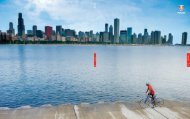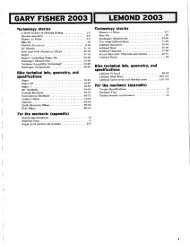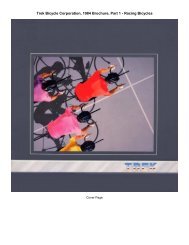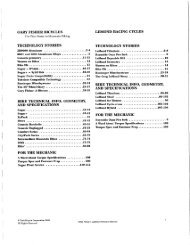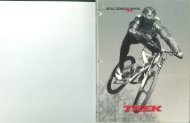TECHNOLOGY STORIES BIKE INFO, GEOMETRY ... - Vintage Trek
TECHNOLOGY STORIES BIKE INFO, GEOMETRY ... - Vintage Trek
TECHNOLOGY STORIES BIKE INFO, GEOMETRY ... - Vintage Trek
You also want an ePaper? Increase the reach of your titles
YUMPU automatically turns print PDFs into web optimized ePapers that Google loves.
Developed for the <strong>Trek</strong> Professional mountain bike<br />
team, the basic concept of Pro Geometry is a bike that<br />
better handles the higher speeds of Pro racers. There<br />
are several key features used in Pro geometry to accomplish<br />
these goals.<br />
Position<br />
The rider compartment is slightly more upright.<br />
A road rider needs to be bent into an aerodynamic<br />
position because wind resistance is a major source of<br />
fatigue on the road. A road racer’s average speed is in<br />
the 20mph range and higher. Mountain bikes usually<br />
only go this fast downhill, so you don’t need to be<br />
bent over as much. Another argument for an upright<br />
position is balance. In humans, the body’s balance<br />
mechanisms are mostly in the head. Your sense of<br />
body position is anchored by your vision. If your<br />
eyes are parallel with the horizon, your balance is<br />
improved. With a more upright position, it’s easier to<br />
keep your head oriented for optimal balance. Better<br />
balance is critical to handling technical terrain or<br />
carving a fast turn on singletrack.<br />
Long front/center<br />
Pro Geometry uses a long front/center. Front/center is<br />
the distance from the bottom bracket to the axle of the<br />
front wheel. The location of the front wheel is important,<br />
since it’s the first part of the bike to meet obstacles in<br />
the trail. The front axle is also the pivot point of the bike<br />
when a rider takes a flyer over the handlebars.<br />
With a longer front/center, the front wheel is pushed<br />
further ahead of you. When you find yourself moving<br />
back on your bike, it’s usually in response to your body<br />
wanting to flip over the front axle. This happens on<br />
steep downhills, and also any time the bike is moving at<br />
high speed in rough terrain.<br />
When the <strong>Trek</strong> engineers moved the front axle forward,<br />
it added resistance to over-the-bars flight. With<br />
this added stability, you’re more relaxed at speed, and<br />
since you’re more in the saddle than behind it, you’re in<br />
a better position to keep the power on the pedals.<br />
Steering<br />
With a long front/center, a bike needs a longer top<br />
tube. To correctly place your hands when riding a bike<br />
with a long top tube, you must use a shorter stem. The<br />
shorter stem used with Pro Geometry puts your hands<br />
closer to the steering axis so steering can be done with<br />
your arms instead of a sweeping sideways movement of<br />
your shoulders. Your hands can move faster than your<br />
shoulders, so technical steering is precise at high speed.<br />
Pro geometry is designed around today’s longer forks.<br />
Thanks to the long front/center, Pro geometry places<br />
slightly less weight on the front wheel. Due to a combination<br />
of steering angle, trail, weight distribution, and<br />
a slightly longer wheelbase, a bike with Pro geometry<br />
likes to be steered by angulation, an advanced skill<br />
that allows a rider to stay balanced over the bike’s tire<br />
contact patches through a turn.<br />
The technique is much like a downhill skier's position,<br />
where the torso remains upright while the lower body<br />
is angled for steering. This position keeps the center of<br />
gravity over the skis for maximum edge hold. And if the<br />
skis should slip, the skier can extend to control them.<br />
As a high speed cycling maneuver, this angled position<br />
makes controlling the bike in a corner much easier. If<br />
the tires slide, extending your body keeps your center of<br />
mass on top of the tire contact patches.<br />
2002 <strong>Trek</strong> Technical Manual<br />
Pro Geometry<br />
Handling<br />
Instead of making a bike that steers quickly so you<br />
can adjust your line in a turn, this bike has additional<br />
directional stability that lets you pick a line early and<br />
hold it. It has a touch of understeer, so if you go into<br />
a corner a little too hot, just lean it in a bit more with<br />
a touch of rear brake, and go. Instead of skittering<br />
around and washing the front tire, the additional lean<br />
puts more edge knobs onto the ground, and a Pro<br />
Geometry bike really carves. Coupled with a lightweight<br />
frame, Pro Geometry makes a bike quick from<br />
edge to edge, so it handles tight turns really well. And<br />
the longer wheelbase works like a giant slalom ski so<br />
high speed fire road riding is way fun.<br />
Doesn't the short stem make the bike climb poorly?<br />
Common sense tells us that a longer front center<br />
places less weight on the front wheel. Intuition tells<br />
us that with less weight on the front wheel, the bike<br />
might not climb well. But geometry charts only tell<br />
part of the story, and a Pro Geometry bike actually<br />
climbs very well. Here’s two reasons why: with a shorter<br />
stem, your shoulders stay more over the centerline<br />
of the bike, even when turning. When your center of<br />
gravity stays over the frame centerline, the bike stays<br />
in better balance. With Pro Geometry, it’s even easier<br />
to hold your line on steep, slow speed climbs. Secondly,<br />
when climbing hard in first gear any bike will respond<br />
to the pressure of pedaling. Imagine if the headset<br />
were placed in the middle of the bike, right below the<br />
saddle. The bike would hinge in the middle, between<br />
contact patches of the tires. With every pedal stroke<br />
the rear wheel would turn away from the pedaling<br />
force. As a result, the front wheel would turn toward<br />
the pedal side, and the bike would swim like a salmon<br />
heading upstream. But the further ahead you move<br />
the pivot (headset), and the closer to your hands, the<br />
straighter the bike will climb. With the shorter stem<br />
used in Pro geometry, you stay over the bike, and<br />
the bike tracks straighter, making it climb very well<br />
indeed.<br />
Fitting Pro Geometry frames<br />
Pro Geometry bikes (OCLV hardtails, Alpha SLR,<br />
ZR9000, Fuel, and STP) are designed to put you in<br />
a similar position to our other performance mountain<br />
bikes. The only difference in position is that the larger<br />
sizes of Pro Geometry use taller head tubes than we<br />
offered in the past. With taller head tubes and 25mm<br />
of spacers it may be necessary to move some spacers<br />
to the top of the stem if you prefer a more deeply<br />
bent-over fit.<br />
7




